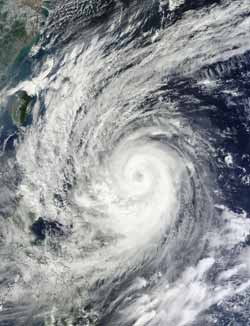NASA Sees Typhoon Prapiroon Doing a "Sit and Spin" in the Philippine Sea

NASA's Terra satellite passed over Typhoon Prapiroon on Oct. 11 at 0210 UTC (1010 p.m. EDT, Oct. 10) and captured a visible image of the storm while it was in the Philippine Sea. Credit: NASA Goddard MODIS Rapid Response Team<br>
NASA's Terra satellite passed over Typhoon Prapiroon on Oct. 11 at 0210 UTC (1010 p.m. EDT, Oct. 10) and the Moderate Resolution Imaging Spectroradiometer (MODIS) instrument captured a visible image of the storm. The visible imagery clearly showed a small ragged eye, and microwave satellite imagery confirmed the eye. Satellite imagery also confirmed a well-defined low-level center of circulation.
By 11 a.m. EDT on Oct. 11, Prapiroon's maximum sustained winds were near 95 knots. It was located about 415 nautical miles south of Kadena Air Base, Okinawa, Japan, near 19.4 North and 128.5 East and not moving.
The storm slowed to a quasi-stationary position between two ridges (elongated areas) of high pressure. Prapiroon is expected to get a jump start again and get most of its steering influenced by the ridge located the east of the storm.
According to the forecasters at the Joint Typhoon Warning Center, between [12 and 24 hours from 11 a.m. EDT on Oct 11] Prapiroon is expected to Slowly re-curve around the western extent of the subtropical ridge and take on a northeastward track over the next three days.
Text credit: Rob Gutro
NASA's Goddard Space Flight Center, Greenbelt, Md.
Media Contact
All latest news from the category: Earth Sciences
Earth Sciences (also referred to as Geosciences), which deals with basic issues surrounding our planet, plays a vital role in the area of energy and raw materials supply.
Earth Sciences comprises subjects such as geology, geography, geological informatics, paleontology, mineralogy, petrography, crystallography, geophysics, geodesy, glaciology, cartography, photogrammetry, meteorology and seismology, early-warning systems, earthquake research and polar research.
Newest articles

Superradiant atoms could push the boundaries of how precisely time can be measured
Superradiant atoms can help us measure time more precisely than ever. In a new study, researchers from the University of Copenhagen present a new method for measuring the time interval,…

Ion thermoelectric conversion devices for near room temperature
The electrode sheet of the thermoelectric device consists of ionic hydrogel, which is sandwiched between the electrodes to form, and the Prussian blue on the electrode undergoes a redox reaction…

Zap Energy achieves 37-million-degree temperatures in a compact device
New publication reports record electron temperatures for a small-scale, sheared-flow-stabilized Z-pinch fusion device. In the nine decades since humans first produced fusion reactions, only a few fusion technologies have demonstrated…





















